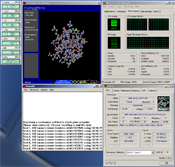SANDRA, Overclocking And Stress-Testing
Below are synthetic benchmark tests with SiSoftware's SANDRA, the System ANalyzer, Diagnostic and Reporting Assistant. SANDRA consists of a set of information and diagnostic utilities that can provide a host of useful information about your hardware and operating system. We ran four of the built-in subsystem tests that partially comprise the SANDRA 2005 suite (CPU, Multimedia, Cache, and Memory) with the Athlon 64 FX-60 installed into our test rig. All of the scores reported below were taken with the processor running at its default clock speeds of 2.6GHz.
|
 CPU Arithmetic Benchmark Athlon 64 FX-60 2.6GHz |
 Multimedia Benchmark Athlon 64 FX-60 2.6GHz |
 CPU Cache Benchmark Athlon 64 FX-60 2.6GHz (DDR2 400) |
 Memory Benchmark Athlon 64 FX-60 2.6GHz (DDR2 400) |
SANDRA's CPU test reports that the Athlon 64 FX-60 is the single fastest CPU in terms of Dhrystone ALU performance and second only to the Intel Extreme Edition in terms of Whetstone FPU calculations. This test also showcases the FX-60's 200MHz advantage, with scores significantly faster in both cases, versus the Athlon 64 X2 4800+ reference system. The Multimedia tests show a very similar scaling with the FX-60's faster Integer performance and the Pentium Extreme Edition showing better FPU throughput. Cache & Memory benchmark show the Athlon 64 FX-60 performs a bit better in terms of available bandwidth versus the reference Athlon 64 FX-53 but not in the same league as any of the Intel dual core Pentiums in the database. The memory bandwidth benchmark reported peak bandwidth scores just under 6GB/second, which is some of the fastest standard DDR400-based performance this test has shown us to date with an Athlon 64 X2 processor.
 |
|
 In our next series of tests, we decided to stress the chip a bit more with some overclocking at full CPU load. The goal here was to determine what the Athlon 64 FX-60's threshold of pain was, while utilizing standard air cooling practices. To be fair, we should note that we used a very leading-edge and capable CPU cooler throughout our testing, Zalman's CPNS9500 LED all copper integrated HSF cooler. This Zalman cooler has brought down temperatures on high-end CPUs in our test labs, by an average of 5oC or more. In fact, under full load with Prime 95 and Folding@Home clients running at an overclock of 3GHz, the Athlon 64 FX-60 only reached a 50oC core temperature in an open air test bench environment. Core temps in a closed case configuration would undoubtedly be higher but regardless, with the excellent performance of this particular Zalman cooler, along with the Athlon 64 FX-60's moderate thermal characteristics, our results overall were rather impressive.
In our next series of tests, we decided to stress the chip a bit more with some overclocking at full CPU load. The goal here was to determine what the Athlon 64 FX-60's threshold of pain was, while utilizing standard air cooling practices. To be fair, we should note that we used a very leading-edge and capable CPU cooler throughout our testing, Zalman's CPNS9500 LED all copper integrated HSF cooler. This Zalman cooler has brought down temperatures on high-end CPUs in our test labs, by an average of 5oC or more. In fact, under full load with Prime 95 and Folding@Home clients running at an overclock of 3GHz, the Athlon 64 FX-60 only reached a 50oC core temperature in an open air test bench environment. Core temps in a closed case configuration would undoubtedly be higher but regardless, with the excellent performance of this particular Zalman cooler, along with the Athlon 64 FX-60's moderate thermal characteristics, our results overall were rather impressive.
To achieve the 3GHz mark we only had to change the CPU core multiplier to 15X in the BIOS and leave the system clock speed at a standard 200MHz which allowed us to keep system memory and HyperTransport speeds within specifications. We did increase the core voltage to 1.3V + .2V boost for 1.5V total as well in the CPU voltage settings of our Asus A8N32 SLI test system motherboard. The new AMD core proved itself to be very stable at this configuration, remaining glitch-free after several extensive 100% CPU load tests. The obligatory "no guarantees" rule of overclocking applies here but we're fairly confident that anyone interested in taking the Athlon 64 FX-60 higher will realize very positive results, at the very least completely stable 2.8GHz operation and that's with perhaps a more modest CPU cooler than we used as well.
Athlon 64 FX-60 @ 3GHz - SANDRA CPU, Memory and Multimedia Tests
Faster than an Athlon 64 X2 4800+ dual core CPU by 600MHz and faster than AMD's Athlon 64 FX-57 single core CPU by 200MHz, an overclocked 3GHz dual core Athlon 64 FX-60 is a thing of beauty. AMD clearly has more room to grow with this dual core architecture, even within the confines of 90nm SOI process technology, which almost sounds silly to say, since 90nm fabrication is very much state-of-the-art. Although 65nm is on the horizon for AMD as well.









